Physiological Changes in Asthma Patients: A Case Study of Ben Marshall
VerifiedAdded on 2023/06/12
|10
|3223
|254
AI Summary
This essay discusses the case of Ben Marshall, a patient diagnosed with severe asthma. It covers his medical history, hospital presentation, altered physiology due to principal diagnosis, and health assessment. The essay also explains the physiological changes that occur in asthma patients and how it affects their respiratory system.
Contribute Materials
Your contribution can guide someone’s learning journey. Share your
documents today.
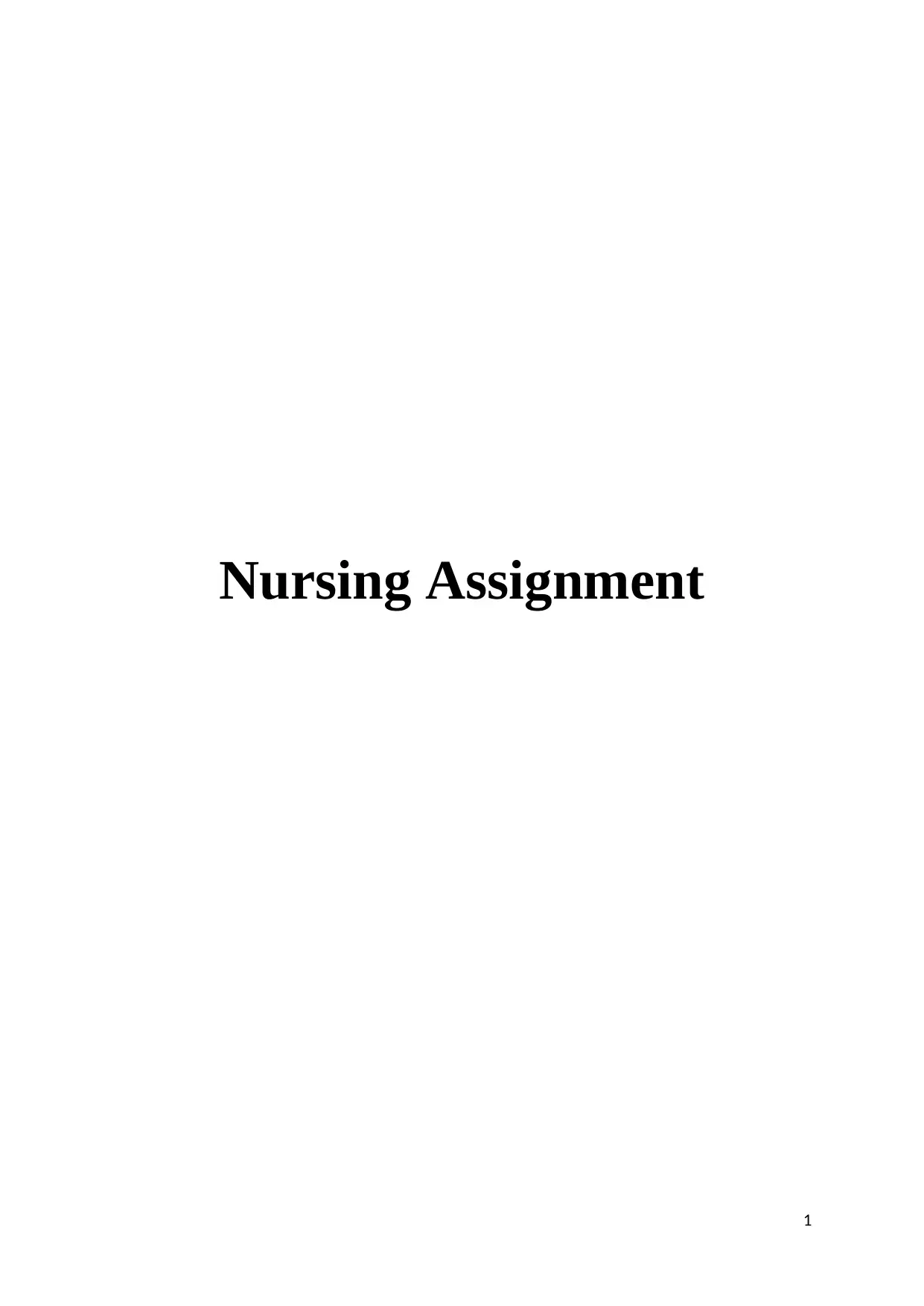
Nursing Assignment
1
1
Secure Best Marks with AI Grader
Need help grading? Try our AI Grader for instant feedback on your assignments.
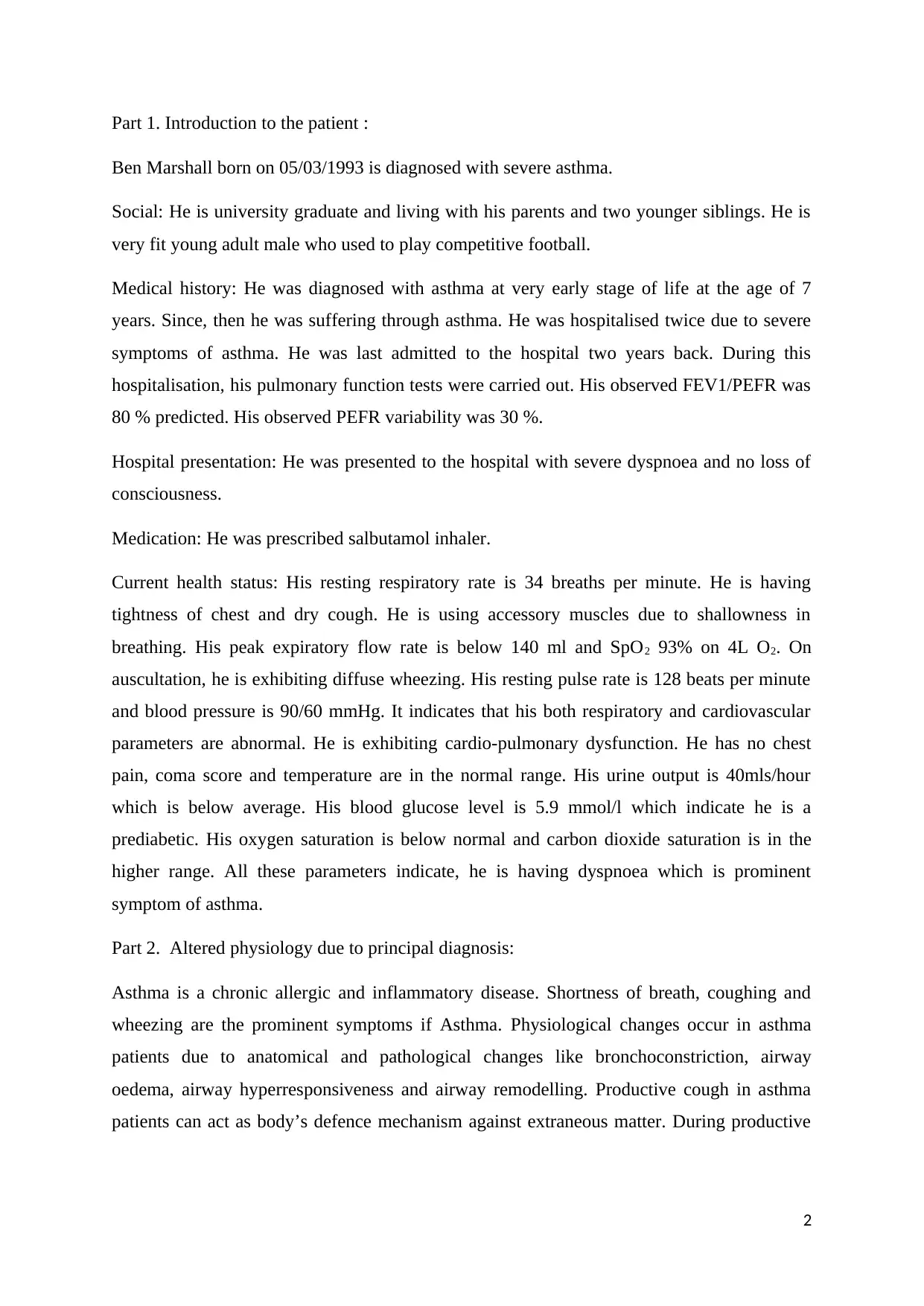
Part 1. Introduction to the patient :
Ben Marshall born on 05/03/1993 is diagnosed with severe asthma.
Social: He is university graduate and living with his parents and two younger siblings. He is
very fit young adult male who used to play competitive football.
Medical history: He was diagnosed with asthma at very early stage of life at the age of 7
years. Since, then he was suffering through asthma. He was hospitalised twice due to severe
symptoms of asthma. He was last admitted to the hospital two years back. During this
hospitalisation, his pulmonary function tests were carried out. His observed FEV1/PEFR was
80 % predicted. His observed PEFR variability was 30 %.
Hospital presentation: He was presented to the hospital with severe dyspnoea and no loss of
consciousness.
Medication: He was prescribed salbutamol inhaler.
Current health status: His resting respiratory rate is 34 breaths per minute. He is having
tightness of chest and dry cough. He is using accessory muscles due to shallowness in
breathing. His peak expiratory flow rate is below 140 ml and SpO2 93% on 4L O2. On
auscultation, he is exhibiting diffuse wheezing. His resting pulse rate is 128 beats per minute
and blood pressure is 90/60 mmHg. It indicates that his both respiratory and cardiovascular
parameters are abnormal. He is exhibiting cardio-pulmonary dysfunction. He has no chest
pain, coma score and temperature are in the normal range. His urine output is 40mls/hour
which is below average. His blood glucose level is 5.9 mmol/l which indicate he is a
prediabetic. His oxygen saturation is below normal and carbon dioxide saturation is in the
higher range. All these parameters indicate, he is having dyspnoea which is prominent
symptom of asthma.
Part 2. Altered physiology due to principal diagnosis:
Asthma is a chronic allergic and inflammatory disease. Shortness of breath, coughing and
wheezing are the prominent symptoms if Asthma. Physiological changes occur in asthma
patients due to anatomical and pathological changes like bronchoconstriction, airway
oedema, airway hyperresponsiveness and airway remodelling. Productive cough in asthma
patients can act as body’s defence mechanism against extraneous matter. During productive
2
Ben Marshall born on 05/03/1993 is diagnosed with severe asthma.
Social: He is university graduate and living with his parents and two younger siblings. He is
very fit young adult male who used to play competitive football.
Medical history: He was diagnosed with asthma at very early stage of life at the age of 7
years. Since, then he was suffering through asthma. He was hospitalised twice due to severe
symptoms of asthma. He was last admitted to the hospital two years back. During this
hospitalisation, his pulmonary function tests were carried out. His observed FEV1/PEFR was
80 % predicted. His observed PEFR variability was 30 %.
Hospital presentation: He was presented to the hospital with severe dyspnoea and no loss of
consciousness.
Medication: He was prescribed salbutamol inhaler.
Current health status: His resting respiratory rate is 34 breaths per minute. He is having
tightness of chest and dry cough. He is using accessory muscles due to shallowness in
breathing. His peak expiratory flow rate is below 140 ml and SpO2 93% on 4L O2. On
auscultation, he is exhibiting diffuse wheezing. His resting pulse rate is 128 beats per minute
and blood pressure is 90/60 mmHg. It indicates that his both respiratory and cardiovascular
parameters are abnormal. He is exhibiting cardio-pulmonary dysfunction. He has no chest
pain, coma score and temperature are in the normal range. His urine output is 40mls/hour
which is below average. His blood glucose level is 5.9 mmol/l which indicate he is a
prediabetic. His oxygen saturation is below normal and carbon dioxide saturation is in the
higher range. All these parameters indicate, he is having dyspnoea which is prominent
symptom of asthma.
Part 2. Altered physiology due to principal diagnosis:
Asthma is a chronic allergic and inflammatory disease. Shortness of breath, coughing and
wheezing are the prominent symptoms if Asthma. Physiological changes occur in asthma
patients due to anatomical and pathological changes like bronchoconstriction, airway
oedema, airway hyperresponsiveness and airway remodelling. Productive cough in asthma
patients can act as body’s defence mechanism against extraneous matter. During productive
2
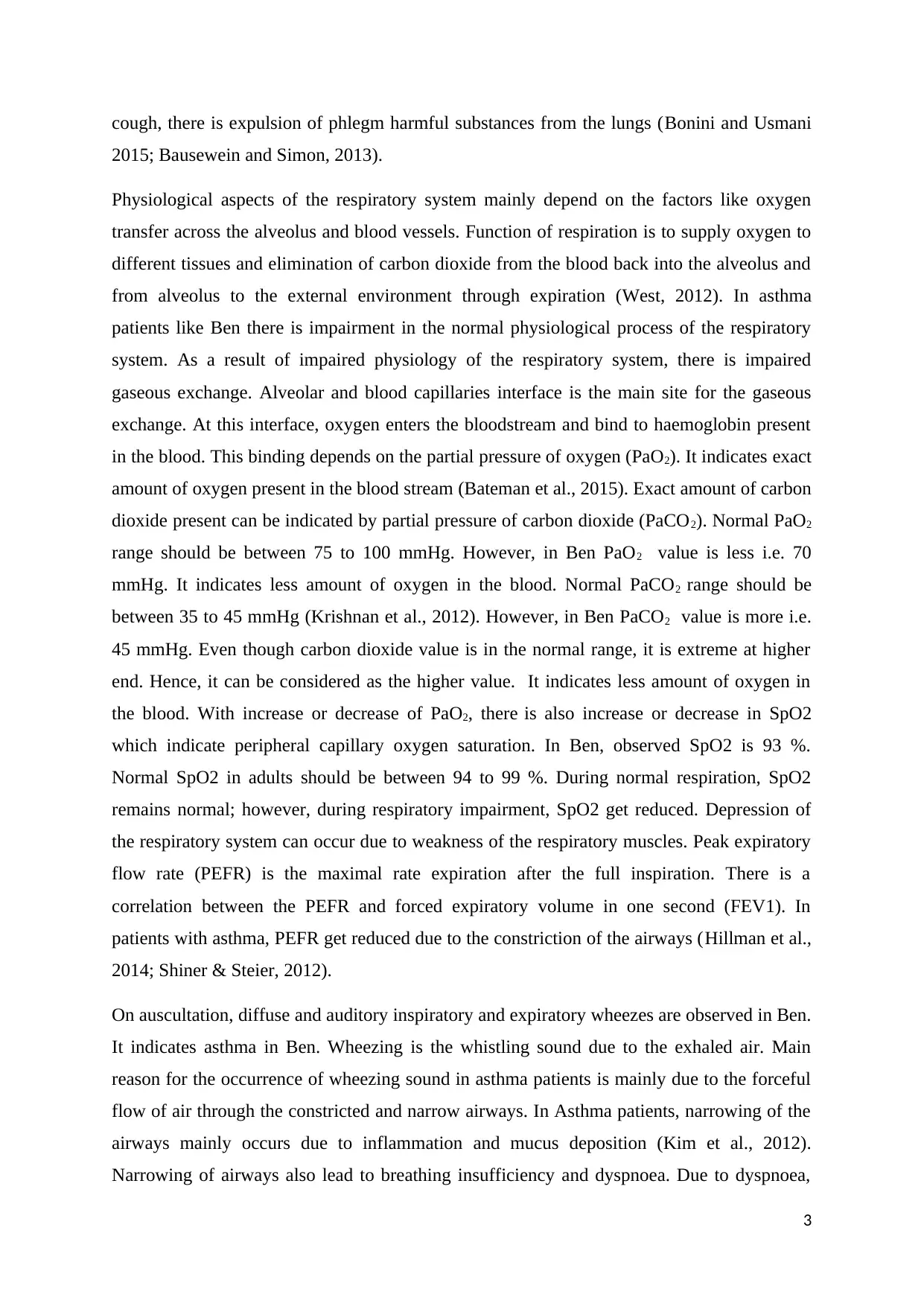
cough, there is expulsion of phlegm harmful substances from the lungs (Bonini and Usmani
2015; Bausewein and Simon, 2013).
Physiological aspects of the respiratory system mainly depend on the factors like oxygen
transfer across the alveolus and blood vessels. Function of respiration is to supply oxygen to
different tissues and elimination of carbon dioxide from the blood back into the alveolus and
from alveolus to the external environment through expiration (West, 2012). In asthma
patients like Ben there is impairment in the normal physiological process of the respiratory
system. As a result of impaired physiology of the respiratory system, there is impaired
gaseous exchange. Alveolar and blood capillaries interface is the main site for the gaseous
exchange. At this interface, oxygen enters the bloodstream and bind to haemoglobin present
in the blood. This binding depends on the partial pressure of oxygen (PaO2). It indicates exact
amount of oxygen present in the blood stream (Bateman et al., 2015). Exact amount of carbon
dioxide present can be indicated by partial pressure of carbon dioxide (PaCO2). Normal PaO2
range should be between 75 to 100 mmHg. However, in Ben PaO2 value is less i.e. 70
mmHg. It indicates less amount of oxygen in the blood. Normal PaCO2 range should be
between 35 to 45 mmHg (Krishnan et al., 2012). However, in Ben PaCO2 value is more i.e.
45 mmHg. Even though carbon dioxide value is in the normal range, it is extreme at higher
end. Hence, it can be considered as the higher value. It indicates less amount of oxygen in
the blood. With increase or decrease of PaO2, there is also increase or decrease in SpO2
which indicate peripheral capillary oxygen saturation. In Ben, observed SpO2 is 93 %.
Normal SpO2 in adults should be between 94 to 99 %. During normal respiration, SpO2
remains normal; however, during respiratory impairment, SpO2 get reduced. Depression of
the respiratory system can occur due to weakness of the respiratory muscles. Peak expiratory
flow rate (PEFR) is the maximal rate expiration after the full inspiration. There is a
correlation between the PEFR and forced expiratory volume in one second (FEV1). In
patients with asthma, PEFR get reduced due to the constriction of the airways (Hillman et al.,
2014; Shiner & Steier, 2012).
On auscultation, diffuse and auditory inspiratory and expiratory wheezes are observed in Ben.
It indicates asthma in Ben. Wheezing is the whistling sound due to the exhaled air. Main
reason for the occurrence of wheezing sound in asthma patients is mainly due to the forceful
flow of air through the constricted and narrow airways. In Asthma patients, narrowing of the
airways mainly occurs due to inflammation and mucus deposition (Kim et al., 2012).
Narrowing of airways also lead to breathing insufficiency and dyspnoea. Due to dyspnoea,
3
2015; Bausewein and Simon, 2013).
Physiological aspects of the respiratory system mainly depend on the factors like oxygen
transfer across the alveolus and blood vessels. Function of respiration is to supply oxygen to
different tissues and elimination of carbon dioxide from the blood back into the alveolus and
from alveolus to the external environment through expiration (West, 2012). In asthma
patients like Ben there is impairment in the normal physiological process of the respiratory
system. As a result of impaired physiology of the respiratory system, there is impaired
gaseous exchange. Alveolar and blood capillaries interface is the main site for the gaseous
exchange. At this interface, oxygen enters the bloodstream and bind to haemoglobin present
in the blood. This binding depends on the partial pressure of oxygen (PaO2). It indicates exact
amount of oxygen present in the blood stream (Bateman et al., 2015). Exact amount of carbon
dioxide present can be indicated by partial pressure of carbon dioxide (PaCO2). Normal PaO2
range should be between 75 to 100 mmHg. However, in Ben PaO2 value is less i.e. 70
mmHg. It indicates less amount of oxygen in the blood. Normal PaCO2 range should be
between 35 to 45 mmHg (Krishnan et al., 2012). However, in Ben PaCO2 value is more i.e.
45 mmHg. Even though carbon dioxide value is in the normal range, it is extreme at higher
end. Hence, it can be considered as the higher value. It indicates less amount of oxygen in
the blood. With increase or decrease of PaO2, there is also increase or decrease in SpO2
which indicate peripheral capillary oxygen saturation. In Ben, observed SpO2 is 93 %.
Normal SpO2 in adults should be between 94 to 99 %. During normal respiration, SpO2
remains normal; however, during respiratory impairment, SpO2 get reduced. Depression of
the respiratory system can occur due to weakness of the respiratory muscles. Peak expiratory
flow rate (PEFR) is the maximal rate expiration after the full inspiration. There is a
correlation between the PEFR and forced expiratory volume in one second (FEV1). In
patients with asthma, PEFR get reduced due to the constriction of the airways (Hillman et al.,
2014; Shiner & Steier, 2012).
On auscultation, diffuse and auditory inspiratory and expiratory wheezes are observed in Ben.
It indicates asthma in Ben. Wheezing is the whistling sound due to the exhaled air. Main
reason for the occurrence of wheezing sound in asthma patients is mainly due to the forceful
flow of air through the constricted and narrow airways. In Asthma patients, narrowing of the
airways mainly occurs due to inflammation and mucus deposition (Kim et al., 2012).
Narrowing of airways also lead to breathing insufficiency and dyspnoea. Due to dyspnoea,
3
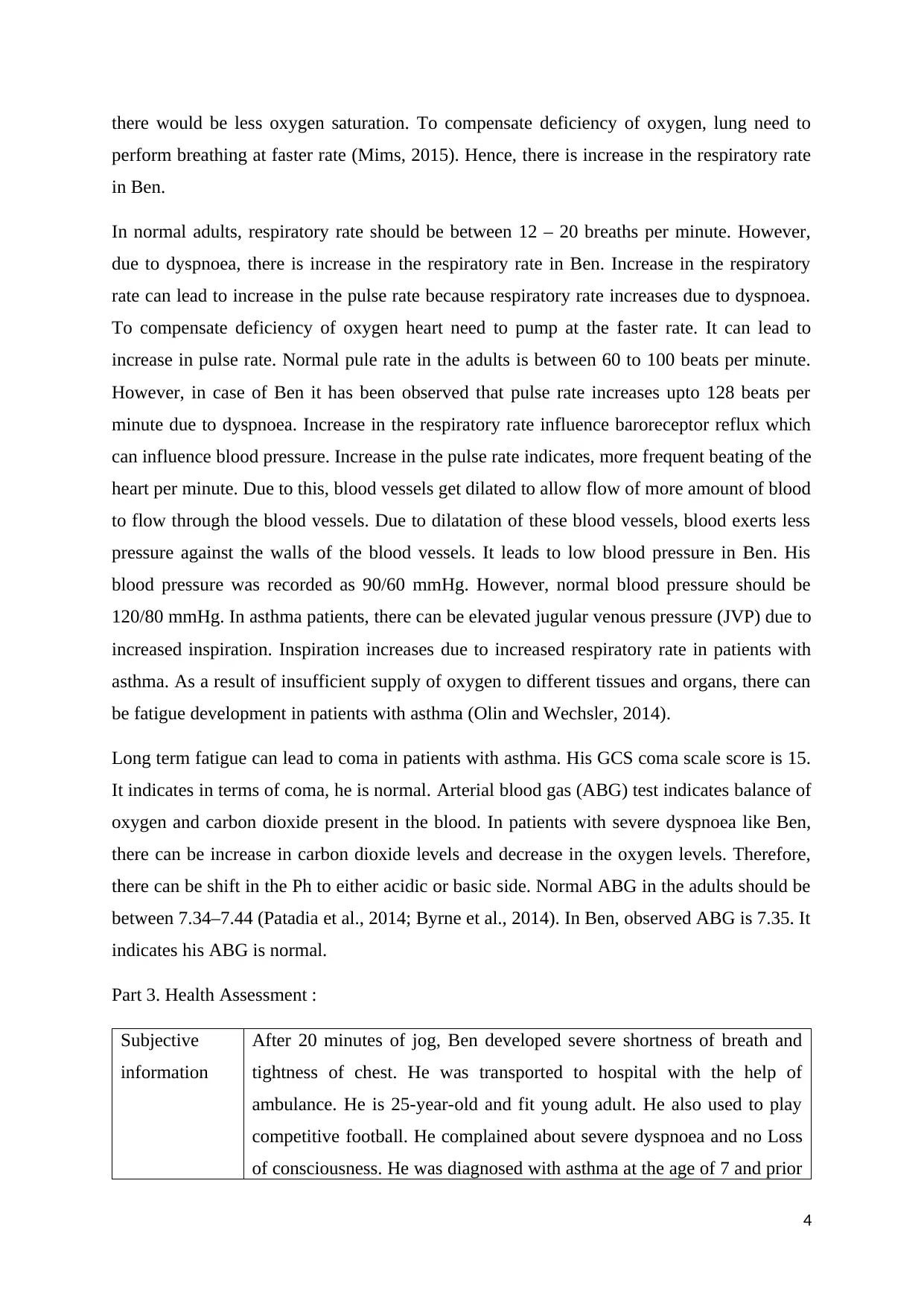
there would be less oxygen saturation. To compensate deficiency of oxygen, lung need to
perform breathing at faster rate (Mims, 2015). Hence, there is increase in the respiratory rate
in Ben.
In normal adults, respiratory rate should be between 12 – 20 breaths per minute. However,
due to dyspnoea, there is increase in the respiratory rate in Ben. Increase in the respiratory
rate can lead to increase in the pulse rate because respiratory rate increases due to dyspnoea.
To compensate deficiency of oxygen heart need to pump at the faster rate. It can lead to
increase in pulse rate. Normal pule rate in the adults is between 60 to 100 beats per minute.
However, in case of Ben it has been observed that pulse rate increases upto 128 beats per
minute due to dyspnoea. Increase in the respiratory rate influence baroreceptor reflux which
can influence blood pressure. Increase in the pulse rate indicates, more frequent beating of the
heart per minute. Due to this, blood vessels get dilated to allow flow of more amount of blood
to flow through the blood vessels. Due to dilatation of these blood vessels, blood exerts less
pressure against the walls of the blood vessels. It leads to low blood pressure in Ben. His
blood pressure was recorded as 90/60 mmHg. However, normal blood pressure should be
120/80 mmHg. In asthma patients, there can be elevated jugular venous pressure (JVP) due to
increased inspiration. Inspiration increases due to increased respiratory rate in patients with
asthma. As a result of insufficient supply of oxygen to different tissues and organs, there can
be fatigue development in patients with asthma (Olin and Wechsler, 2014).
Long term fatigue can lead to coma in patients with asthma. His GCS coma scale score is 15.
It indicates in terms of coma, he is normal. Arterial blood gas (ABG) test indicates balance of
oxygen and carbon dioxide present in the blood. In patients with severe dyspnoea like Ben,
there can be increase in carbon dioxide levels and decrease in the oxygen levels. Therefore,
there can be shift in the Ph to either acidic or basic side. Normal ABG in the adults should be
between 7.34–7.44 (Patadia et al., 2014; Byrne et al., 2014). In Ben, observed ABG is 7.35. It
indicates his ABG is normal.
Part 3. Health Assessment :
Subjective
information
After 20 minutes of jog, Ben developed severe shortness of breath and
tightness of chest. He was transported to hospital with the help of
ambulance. He is 25-year-old and fit young adult. He also used to play
competitive football. He complained about severe dyspnoea and no Loss
of consciousness. He was diagnosed with asthma at the age of 7 and prior
4
perform breathing at faster rate (Mims, 2015). Hence, there is increase in the respiratory rate
in Ben.
In normal adults, respiratory rate should be between 12 – 20 breaths per minute. However,
due to dyspnoea, there is increase in the respiratory rate in Ben. Increase in the respiratory
rate can lead to increase in the pulse rate because respiratory rate increases due to dyspnoea.
To compensate deficiency of oxygen heart need to pump at the faster rate. It can lead to
increase in pulse rate. Normal pule rate in the adults is between 60 to 100 beats per minute.
However, in case of Ben it has been observed that pulse rate increases upto 128 beats per
minute due to dyspnoea. Increase in the respiratory rate influence baroreceptor reflux which
can influence blood pressure. Increase in the pulse rate indicates, more frequent beating of the
heart per minute. Due to this, blood vessels get dilated to allow flow of more amount of blood
to flow through the blood vessels. Due to dilatation of these blood vessels, blood exerts less
pressure against the walls of the blood vessels. It leads to low blood pressure in Ben. His
blood pressure was recorded as 90/60 mmHg. However, normal blood pressure should be
120/80 mmHg. In asthma patients, there can be elevated jugular venous pressure (JVP) due to
increased inspiration. Inspiration increases due to increased respiratory rate in patients with
asthma. As a result of insufficient supply of oxygen to different tissues and organs, there can
be fatigue development in patients with asthma (Olin and Wechsler, 2014).
Long term fatigue can lead to coma in patients with asthma. His GCS coma scale score is 15.
It indicates in terms of coma, he is normal. Arterial blood gas (ABG) test indicates balance of
oxygen and carbon dioxide present in the blood. In patients with severe dyspnoea like Ben,
there can be increase in carbon dioxide levels and decrease in the oxygen levels. Therefore,
there can be shift in the Ph to either acidic or basic side. Normal ABG in the adults should be
between 7.34–7.44 (Patadia et al., 2014; Byrne et al., 2014). In Ben, observed ABG is 7.35. It
indicates his ABG is normal.
Part 3. Health Assessment :
Subjective
information
After 20 minutes of jog, Ben developed severe shortness of breath and
tightness of chest. He was transported to hospital with the help of
ambulance. He is 25-year-old and fit young adult. He also used to play
competitive football. He complained about severe dyspnoea and no Loss
of consciousness. He was diagnosed with asthma at the age of 7 and prior
4
Secure Best Marks with AI Grader
Need help grading? Try our AI Grader for instant feedback on your assignments.
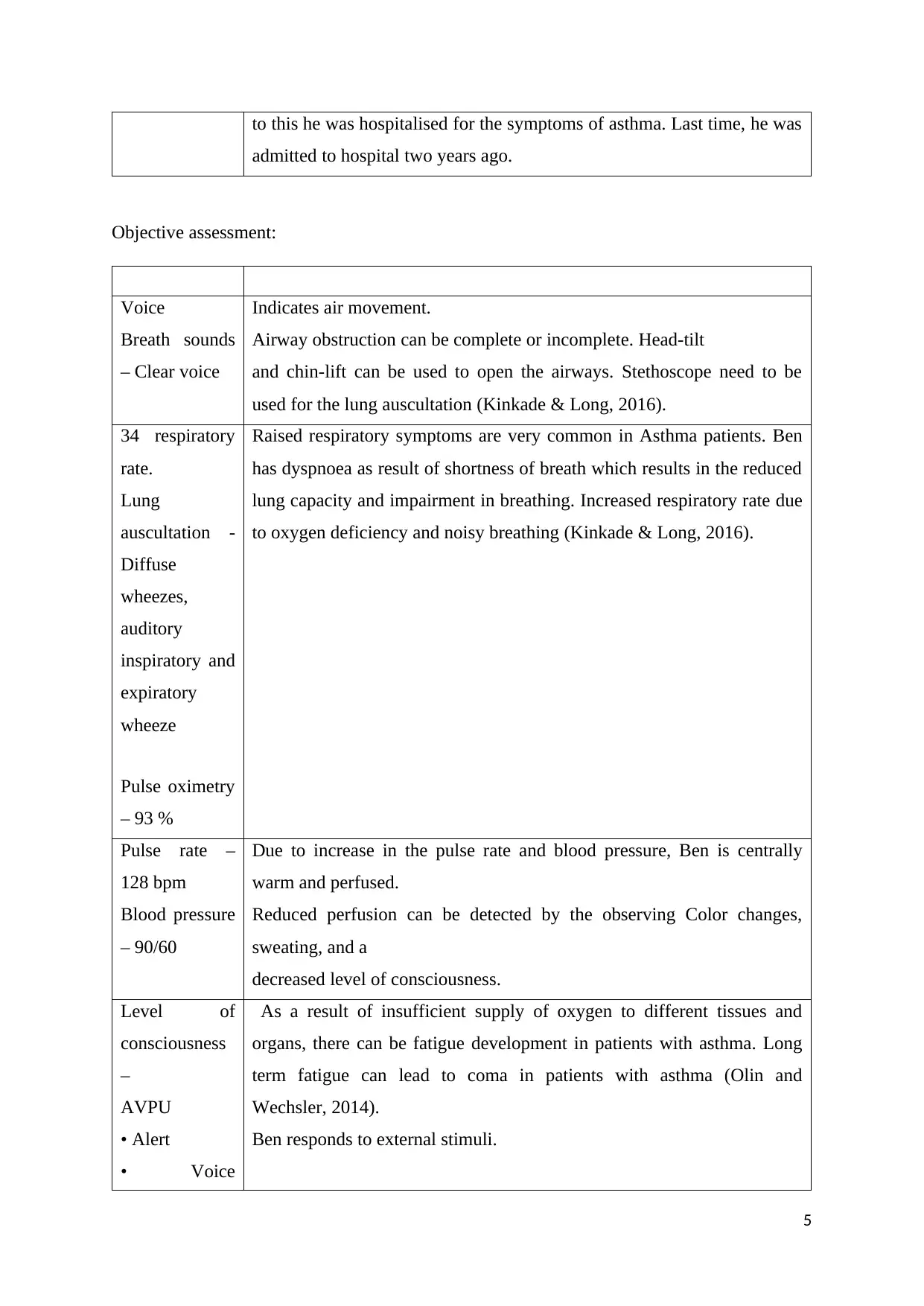
to this he was hospitalised for the symptoms of asthma. Last time, he was
admitted to hospital two years ago.
Objective assessment:
Voice
Breath sounds
– Clear voice
Indicates air movement.
Airway obstruction can be complete or incomplete. Head-tilt
and chin-lift can be used to open the airways. Stethoscope need to be
used for the lung auscultation (Kinkade & Long, 2016).
34 respiratory
rate.
Lung
auscultation -
Diffuse
wheezes,
auditory
inspiratory and
expiratory
wheeze
Pulse oximetry
– 93 %
Raised respiratory symptoms are very common in Asthma patients. Ben
has dyspnoea as result of shortness of breath which results in the reduced
lung capacity and impairment in breathing. Increased respiratory rate due
to oxygen deficiency and noisy breathing (Kinkade & Long, 2016).
Pulse rate –
128 bpm
Blood pressure
– 90/60
Due to increase in the pulse rate and blood pressure, Ben is centrally
warm and perfused.
Reduced perfusion can be detected by the observing Color changes,
sweating, and a
decreased level of consciousness.
Level of
consciousness
–
AVPU
• Alert
• Voice
As a result of insufficient supply of oxygen to different tissues and
organs, there can be fatigue development in patients with asthma. Long
term fatigue can lead to coma in patients with asthma (Olin and
Wechsler, 2014).
Ben responds to external stimuli.
5
admitted to hospital two years ago.
Objective assessment:
Voice
Breath sounds
– Clear voice
Indicates air movement.
Airway obstruction can be complete or incomplete. Head-tilt
and chin-lift can be used to open the airways. Stethoscope need to be
used for the lung auscultation (Kinkade & Long, 2016).
34 respiratory
rate.
Lung
auscultation -
Diffuse
wheezes,
auditory
inspiratory and
expiratory
wheeze
Pulse oximetry
– 93 %
Raised respiratory symptoms are very common in Asthma patients. Ben
has dyspnoea as result of shortness of breath which results in the reduced
lung capacity and impairment in breathing. Increased respiratory rate due
to oxygen deficiency and noisy breathing (Kinkade & Long, 2016).
Pulse rate –
128 bpm
Blood pressure
– 90/60
Due to increase in the pulse rate and blood pressure, Ben is centrally
warm and perfused.
Reduced perfusion can be detected by the observing Color changes,
sweating, and a
decreased level of consciousness.
Level of
consciousness
–
AVPU
• Alert
• Voice
As a result of insufficient supply of oxygen to different tissues and
organs, there can be fatigue development in patients with asthma. Long
term fatigue can lead to coma in patients with asthma (Olin and
Wechsler, 2014).
Ben responds to external stimuli.
5
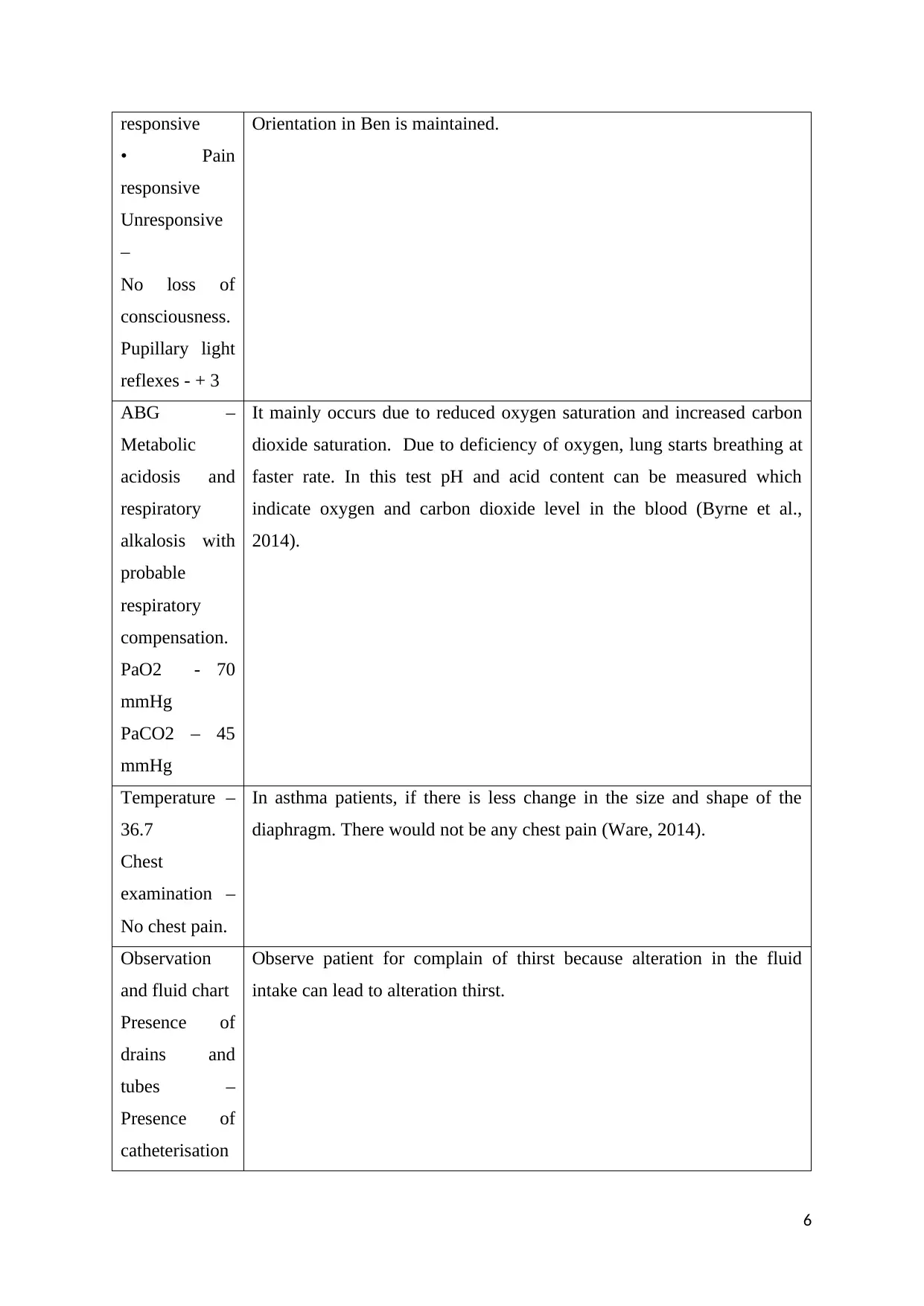
responsive
• Pain
responsive
Unresponsive
–
No loss of
consciousness.
Pupillary light
reflexes - + 3
Orientation in Ben is maintained.
ABG –
Metabolic
acidosis and
respiratory
alkalosis with
probable
respiratory
compensation.
PaO2 - 70
mmHg
PaCO2 – 45
mmHg
It mainly occurs due to reduced oxygen saturation and increased carbon
dioxide saturation. Due to deficiency of oxygen, lung starts breathing at
faster rate. In this test pH and acid content can be measured which
indicate oxygen and carbon dioxide level in the blood (Byrne et al.,
2014).
Temperature –
36.7
Chest
examination –
No chest pain.
In asthma patients, if there is less change in the size and shape of the
diaphragm. There would not be any chest pain (Ware, 2014).
Observation
and fluid chart
Presence of
drains and
tubes –
Presence of
catheterisation
Observe patient for complain of thirst because alteration in the fluid
intake can lead to alteration thirst.
6
• Pain
responsive
Unresponsive
–
No loss of
consciousness.
Pupillary light
reflexes - + 3
Orientation in Ben is maintained.
ABG –
Metabolic
acidosis and
respiratory
alkalosis with
probable
respiratory
compensation.
PaO2 - 70
mmHg
PaCO2 – 45
mmHg
It mainly occurs due to reduced oxygen saturation and increased carbon
dioxide saturation. Due to deficiency of oxygen, lung starts breathing at
faster rate. In this test pH and acid content can be measured which
indicate oxygen and carbon dioxide level in the blood (Byrne et al.,
2014).
Temperature –
36.7
Chest
examination –
No chest pain.
In asthma patients, if there is less change in the size and shape of the
diaphragm. There would not be any chest pain (Ware, 2014).
Observation
and fluid chart
Presence of
drains and
tubes –
Presence of
catheterisation
Observe patient for complain of thirst because alteration in the fluid
intake can lead to alteration thirst.
6
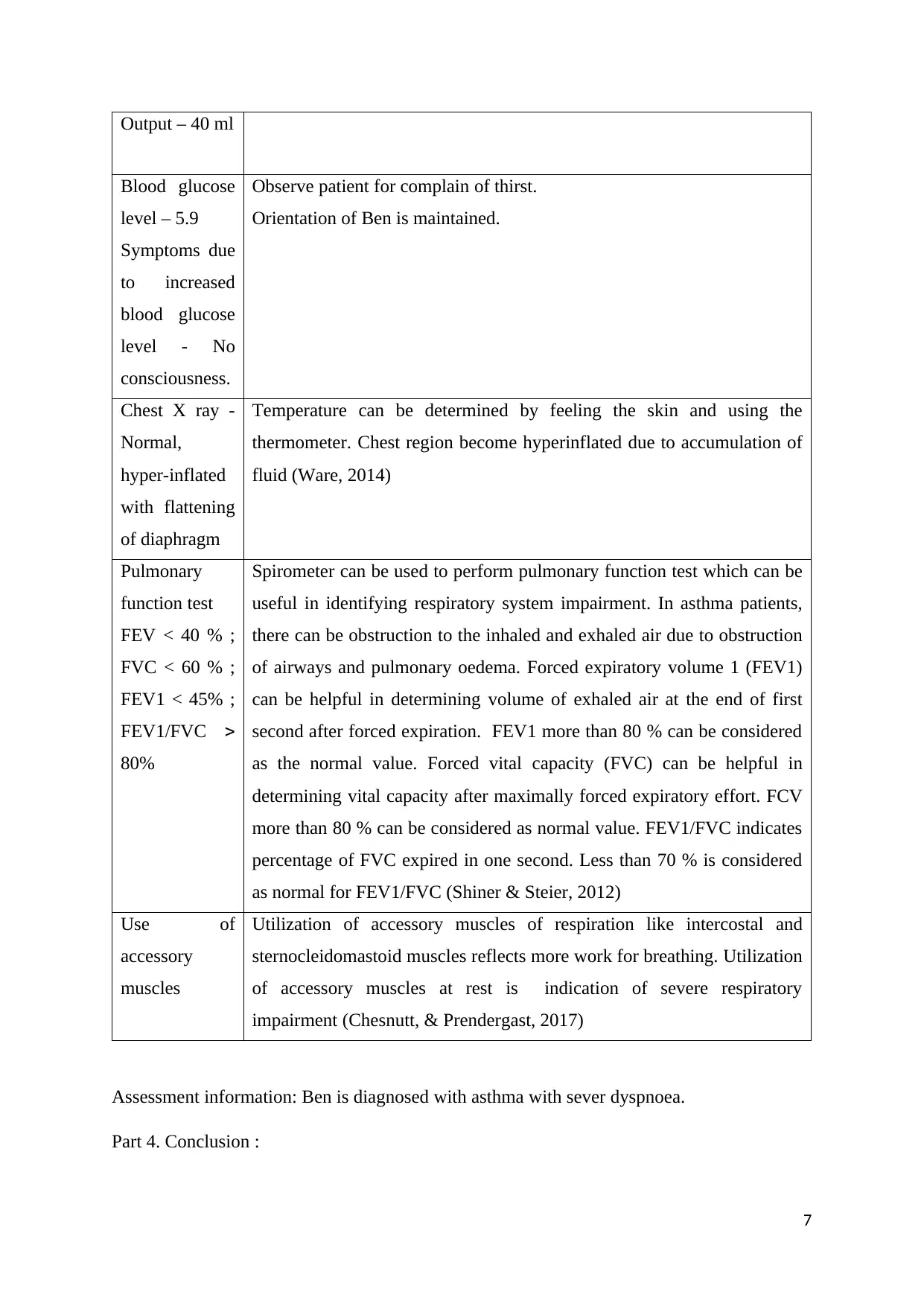
Output – 40 ml
Blood glucose
level – 5.9
Symptoms due
to increased
blood glucose
level - No
consciousness.
Observe patient for complain of thirst.
Orientation of Ben is maintained.
Chest X ray -
Normal,
hyper-inflated
with flattening
of diaphragm
Temperature can be determined by feeling the skin and using the
thermometer. Chest region become hyperinflated due to accumulation of
fluid (Ware, 2014)
Pulmonary
function test
FEV < 40 % ;
FVC < 60 % ;
FEV1 < 45% ;
FEV1/FVC
80%
Spirometer can be used to perform pulmonary function test which can be
useful in identifying respiratory system impairment. In asthma patients,
there can be obstruction to the inhaled and exhaled air due to obstruction
of airways and pulmonary oedema. Forced expiratory volume 1 (FEV1)
can be helpful in determining volume of exhaled air at the end of first
second after forced expiration. FEV1 more than 80 % can be considered
as the normal value. Forced vital capacity (FVC) can be helpful in
determining vital capacity after maximally forced expiratory effort. FCV
more than 80 % can be considered as normal value. FEV1/FVC indicates
percentage of FVC expired in one second. Less than 70 % is considered
as normal for FEV1/FVC (Shiner & Steier, 2012)
Use of
accessory
muscles
Utilization of accessory muscles of respiration like intercostal and
sternocleidomastoid muscles reflects more work for breathing. Utilization
of accessory muscles at rest is indication of severe respiratory
impairment (Chesnutt, & Prendergast, 2017)
Assessment information: Ben is diagnosed with asthma with sever dyspnoea.
Part 4. Conclusion :
7
Blood glucose
level – 5.9
Symptoms due
to increased
blood glucose
level - No
consciousness.
Observe patient for complain of thirst.
Orientation of Ben is maintained.
Chest X ray -
Normal,
hyper-inflated
with flattening
of diaphragm
Temperature can be determined by feeling the skin and using the
thermometer. Chest region become hyperinflated due to accumulation of
fluid (Ware, 2014)
Pulmonary
function test
FEV < 40 % ;
FVC < 60 % ;
FEV1 < 45% ;
FEV1/FVC
80%
Spirometer can be used to perform pulmonary function test which can be
useful in identifying respiratory system impairment. In asthma patients,
there can be obstruction to the inhaled and exhaled air due to obstruction
of airways and pulmonary oedema. Forced expiratory volume 1 (FEV1)
can be helpful in determining volume of exhaled air at the end of first
second after forced expiration. FEV1 more than 80 % can be considered
as the normal value. Forced vital capacity (FVC) can be helpful in
determining vital capacity after maximally forced expiratory effort. FCV
more than 80 % can be considered as normal value. FEV1/FVC indicates
percentage of FVC expired in one second. Less than 70 % is considered
as normal for FEV1/FVC (Shiner & Steier, 2012)
Use of
accessory
muscles
Utilization of accessory muscles of respiration like intercostal and
sternocleidomastoid muscles reflects more work for breathing. Utilization
of accessory muscles at rest is indication of severe respiratory
impairment (Chesnutt, & Prendergast, 2017)
Assessment information: Ben is diagnosed with asthma with sever dyspnoea.
Part 4. Conclusion :
7
Paraphrase This Document
Need a fresh take? Get an instant paraphrase of this document with our AI Paraphraser
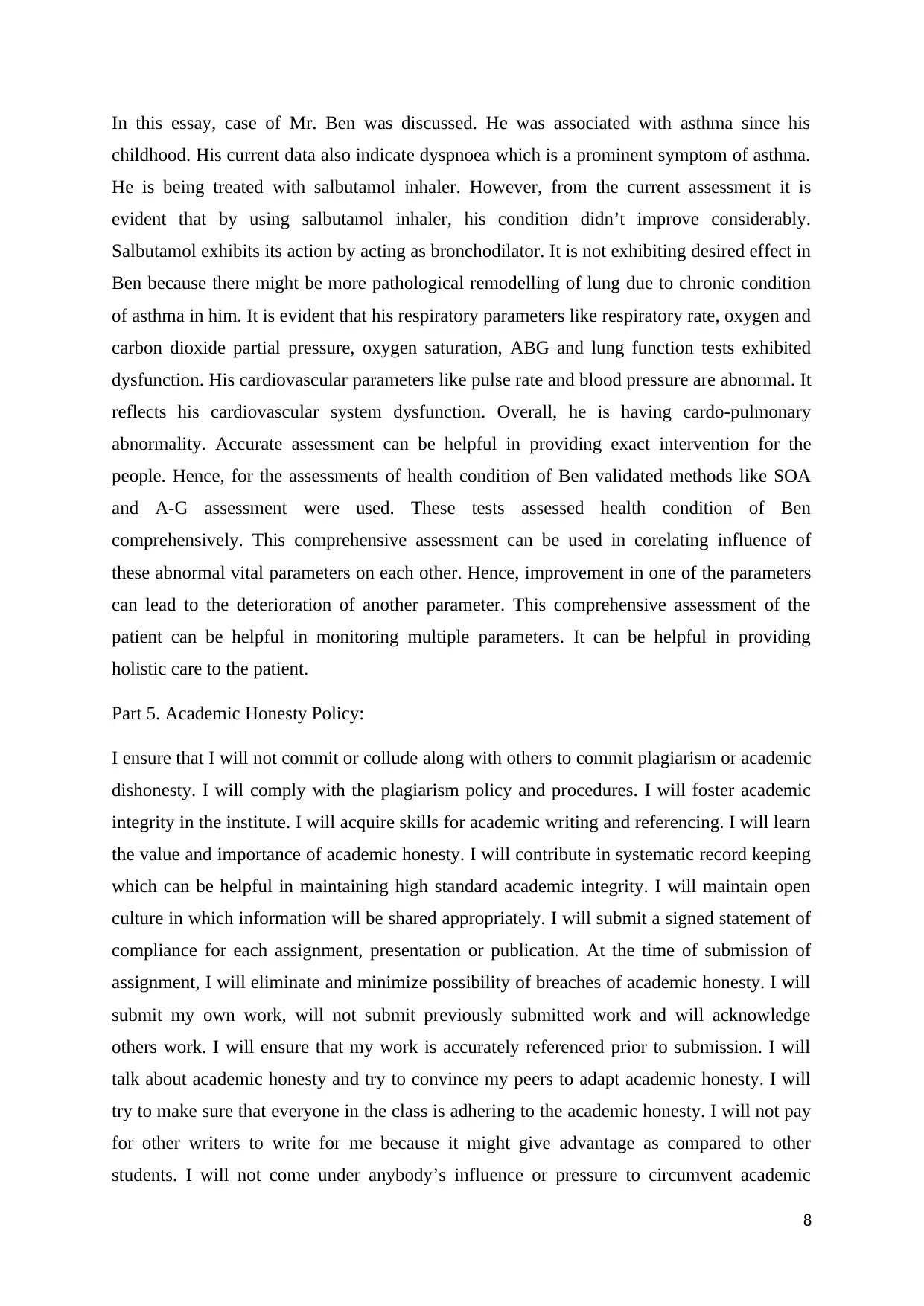
In this essay, case of Mr. Ben was discussed. He was associated with asthma since his
childhood. His current data also indicate dyspnoea which is a prominent symptom of asthma.
He is being treated with salbutamol inhaler. However, from the current assessment it is
evident that by using salbutamol inhaler, his condition didn’t improve considerably.
Salbutamol exhibits its action by acting as bronchodilator. It is not exhibiting desired effect in
Ben because there might be more pathological remodelling of lung due to chronic condition
of asthma in him. It is evident that his respiratory parameters like respiratory rate, oxygen and
carbon dioxide partial pressure, oxygen saturation, ABG and lung function tests exhibited
dysfunction. His cardiovascular parameters like pulse rate and blood pressure are abnormal. It
reflects his cardiovascular system dysfunction. Overall, he is having cardo-pulmonary
abnormality. Accurate assessment can be helpful in providing exact intervention for the
people. Hence, for the assessments of health condition of Ben validated methods like SOA
and A-G assessment were used. These tests assessed health condition of Ben
comprehensively. This comprehensive assessment can be used in corelating influence of
these abnormal vital parameters on each other. Hence, improvement in one of the parameters
can lead to the deterioration of another parameter. This comprehensive assessment of the
patient can be helpful in monitoring multiple parameters. It can be helpful in providing
holistic care to the patient.
Part 5. Academic Honesty Policy:
I ensure that I will not commit or collude along with others to commit plagiarism or academic
dishonesty. I will comply with the plagiarism policy and procedures. I will foster academic
integrity in the institute. I will acquire skills for academic writing and referencing. I will learn
the value and importance of academic honesty. I will contribute in systematic record keeping
which can be helpful in maintaining high standard academic integrity. I will maintain open
culture in which information will be shared appropriately. I will submit a signed statement of
compliance for each assignment, presentation or publication. At the time of submission of
assignment, I will eliminate and minimize possibility of breaches of academic honesty. I will
submit my own work, will not submit previously submitted work and will acknowledge
others work. I will ensure that my work is accurately referenced prior to submission. I will
talk about academic honesty and try to convince my peers to adapt academic honesty. I will
try to make sure that everyone in the class is adhering to the academic honesty. I will not pay
for other writers to write for me because it might give advantage as compared to other
students. I will not come under anybody’s influence or pressure to circumvent academic
8
childhood. His current data also indicate dyspnoea which is a prominent symptom of asthma.
He is being treated with salbutamol inhaler. However, from the current assessment it is
evident that by using salbutamol inhaler, his condition didn’t improve considerably.
Salbutamol exhibits its action by acting as bronchodilator. It is not exhibiting desired effect in
Ben because there might be more pathological remodelling of lung due to chronic condition
of asthma in him. It is evident that his respiratory parameters like respiratory rate, oxygen and
carbon dioxide partial pressure, oxygen saturation, ABG and lung function tests exhibited
dysfunction. His cardiovascular parameters like pulse rate and blood pressure are abnormal. It
reflects his cardiovascular system dysfunction. Overall, he is having cardo-pulmonary
abnormality. Accurate assessment can be helpful in providing exact intervention for the
people. Hence, for the assessments of health condition of Ben validated methods like SOA
and A-G assessment were used. These tests assessed health condition of Ben
comprehensively. This comprehensive assessment can be used in corelating influence of
these abnormal vital parameters on each other. Hence, improvement in one of the parameters
can lead to the deterioration of another parameter. This comprehensive assessment of the
patient can be helpful in monitoring multiple parameters. It can be helpful in providing
holistic care to the patient.
Part 5. Academic Honesty Policy:
I ensure that I will not commit or collude along with others to commit plagiarism or academic
dishonesty. I will comply with the plagiarism policy and procedures. I will foster academic
integrity in the institute. I will acquire skills for academic writing and referencing. I will learn
the value and importance of academic honesty. I will contribute in systematic record keeping
which can be helpful in maintaining high standard academic integrity. I will maintain open
culture in which information will be shared appropriately. I will submit a signed statement of
compliance for each assignment, presentation or publication. At the time of submission of
assignment, I will eliminate and minimize possibility of breaches of academic honesty. I will
submit my own work, will not submit previously submitted work and will acknowledge
others work. I will ensure that my work is accurately referenced prior to submission. I will
talk about academic honesty and try to convince my peers to adapt academic honesty. I will
try to make sure that everyone in the class is adhering to the academic honesty. I will not pay
for other writers to write for me because it might give advantage as compared to other
students. I will not come under anybody’s influence or pressure to circumvent academic
8
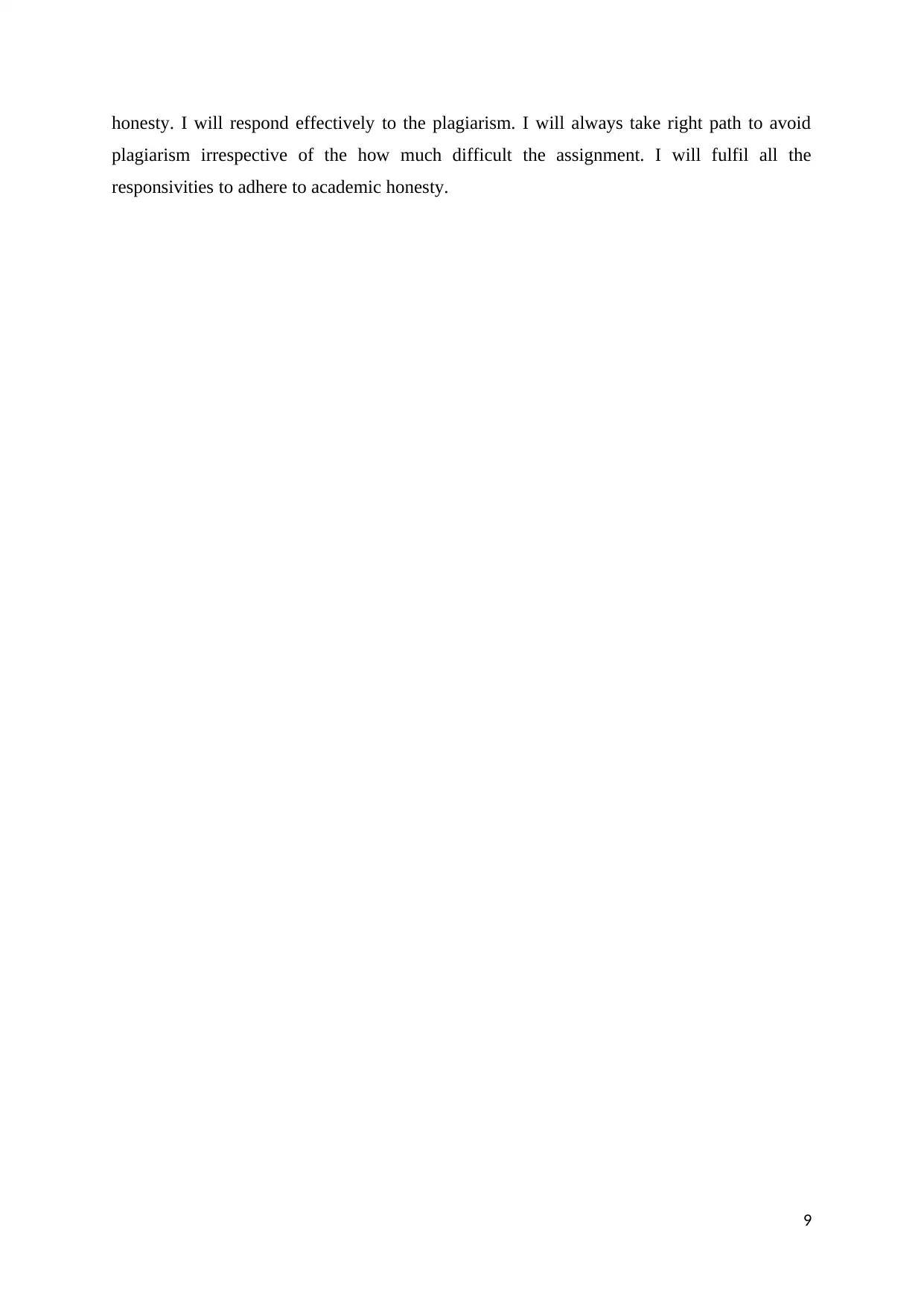
honesty. I will respond effectively to the plagiarism. I will always take right path to avoid
plagiarism irrespective of the how much difficult the assignment. I will fulfil all the
responsivities to adhere to academic honesty.
9
plagiarism irrespective of the how much difficult the assignment. I will fulfil all the
responsivities to adhere to academic honesty.
9
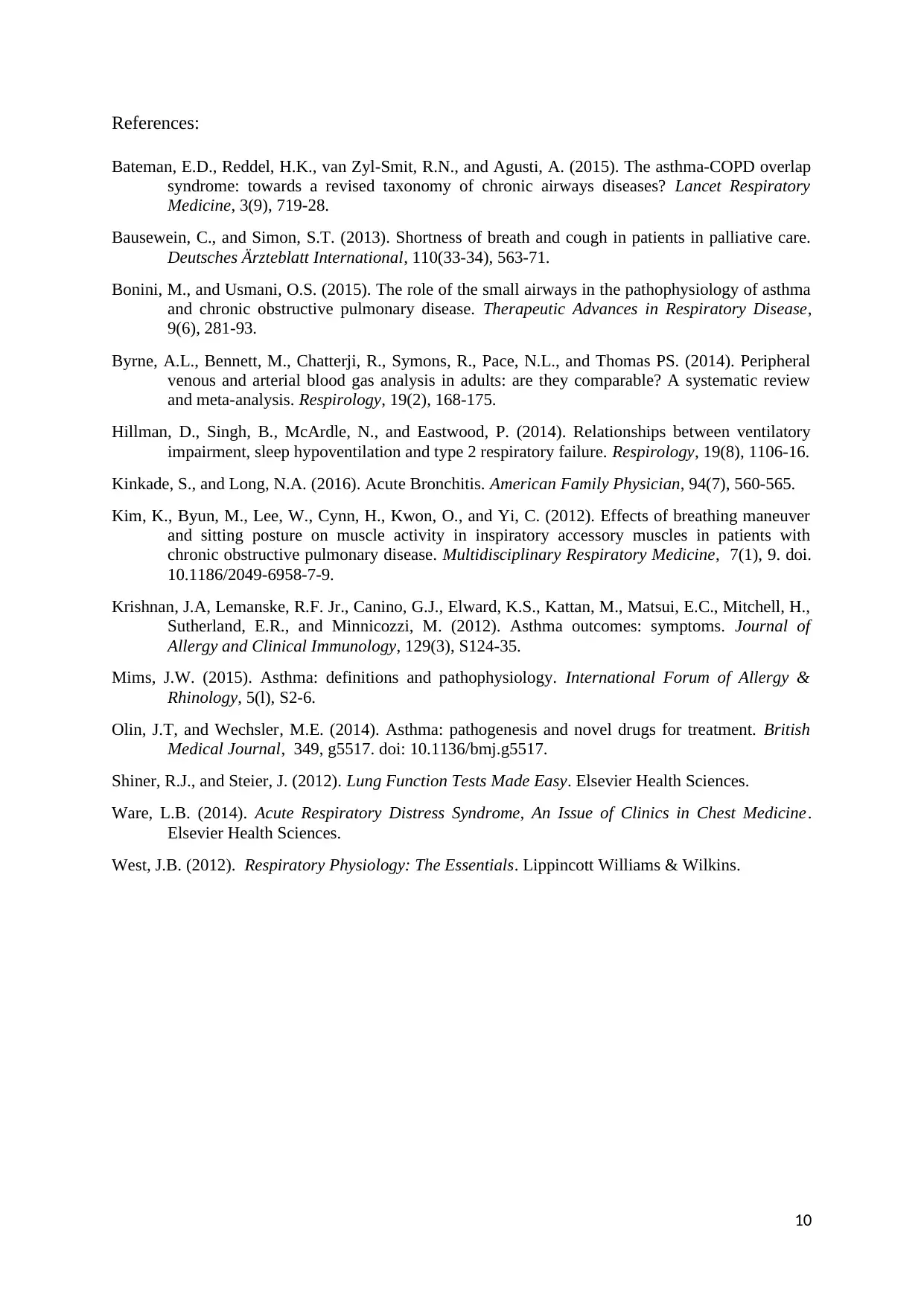
References:
Bateman, E.D., Reddel, H.K., van Zyl-Smit, R.N., and Agusti, A. (2015). The asthma-COPD overlap
syndrome: towards a revised taxonomy of chronic airways diseases? Lancet Respiratory
Medicine, 3(9), 719-28.
Bausewein, C., and Simon, S.T. (2013). Shortness of breath and cough in patients in palliative care.
Deutsches Ärzteblatt International, 110(33-34), 563-71.
Bonini, M., and Usmani, O.S. (2015). The role of the small airways in the pathophysiology of asthma
and chronic obstructive pulmonary disease. Therapeutic Advances in Respiratory Disease,
9(6), 281-93.
Byrne, A.L., Bennett, M., Chatterji, R., Symons, R., Pace, N.L., and Thomas PS. (2014). Peripheral
venous and arterial blood gas analysis in adults: are they comparable? A systematic review
and meta-analysis. Respirology, 19(2), 168-175.
Hillman, D., Singh, B., McArdle, N., and Eastwood, P. (2014). Relationships between ventilatory
impairment, sleep hypoventilation and type 2 respiratory failure. Respirology, 19(8), 1106-16.
Kinkade, S., and Long, N.A. (2016). Acute Bronchitis. American Family Physician, 94(7), 560-565.
Kim, K., Byun, M., Lee, W., Cynn, H., Kwon, O., and Yi, C. (2012). Effects of breathing maneuver
and sitting posture on muscle activity in inspiratory accessory muscles in patients with
chronic obstructive pulmonary disease. Multidisciplinary Respiratory Medicine, 7(1), 9. doi.
10.1186/2049-6958-7-9.
Krishnan, J.A, Lemanske, R.F. Jr., Canino, G.J., Elward, K.S., Kattan, M., Matsui, E.C., Mitchell, H.,
Sutherland, E.R., and Minnicozzi, M. (2012). Asthma outcomes: symptoms. Journal of
Allergy and Clinical Immunology, 129(3), S124-35.
Mims, J.W. (2015). Asthma: definitions and pathophysiology. International Forum of Allergy &
Rhinology, 5(l), S2-6.
Olin, J.T, and Wechsler, M.E. (2014). Asthma: pathogenesis and novel drugs for treatment. British
Medical Journal, 349, g5517. doi: 10.1136/bmj.g5517.
Shiner, R.J., and Steier, J. (2012). Lung Function Tests Made Easy. Elsevier Health Sciences.
Ware, L.B. (2014). Acute Respiratory Distress Syndrome, An Issue of Clinics in Chest Medicine.
Elsevier Health Sciences.
West, J.B. (2012). Respiratory Physiology: The Essentials. Lippincott Williams & Wilkins.
10
Bateman, E.D., Reddel, H.K., van Zyl-Smit, R.N., and Agusti, A. (2015). The asthma-COPD overlap
syndrome: towards a revised taxonomy of chronic airways diseases? Lancet Respiratory
Medicine, 3(9), 719-28.
Bausewein, C., and Simon, S.T. (2013). Shortness of breath and cough in patients in palliative care.
Deutsches Ärzteblatt International, 110(33-34), 563-71.
Bonini, M., and Usmani, O.S. (2015). The role of the small airways in the pathophysiology of asthma
and chronic obstructive pulmonary disease. Therapeutic Advances in Respiratory Disease,
9(6), 281-93.
Byrne, A.L., Bennett, M., Chatterji, R., Symons, R., Pace, N.L., and Thomas PS. (2014). Peripheral
venous and arterial blood gas analysis in adults: are they comparable? A systematic review
and meta-analysis. Respirology, 19(2), 168-175.
Hillman, D., Singh, B., McArdle, N., and Eastwood, P. (2014). Relationships between ventilatory
impairment, sleep hypoventilation and type 2 respiratory failure. Respirology, 19(8), 1106-16.
Kinkade, S., and Long, N.A. (2016). Acute Bronchitis. American Family Physician, 94(7), 560-565.
Kim, K., Byun, M., Lee, W., Cynn, H., Kwon, O., and Yi, C. (2012). Effects of breathing maneuver
and sitting posture on muscle activity in inspiratory accessory muscles in patients with
chronic obstructive pulmonary disease. Multidisciplinary Respiratory Medicine, 7(1), 9. doi.
10.1186/2049-6958-7-9.
Krishnan, J.A, Lemanske, R.F. Jr., Canino, G.J., Elward, K.S., Kattan, M., Matsui, E.C., Mitchell, H.,
Sutherland, E.R., and Minnicozzi, M. (2012). Asthma outcomes: symptoms. Journal of
Allergy and Clinical Immunology, 129(3), S124-35.
Mims, J.W. (2015). Asthma: definitions and pathophysiology. International Forum of Allergy &
Rhinology, 5(l), S2-6.
Olin, J.T, and Wechsler, M.E. (2014). Asthma: pathogenesis and novel drugs for treatment. British
Medical Journal, 349, g5517. doi: 10.1136/bmj.g5517.
Shiner, R.J., and Steier, J. (2012). Lung Function Tests Made Easy. Elsevier Health Sciences.
Ware, L.B. (2014). Acute Respiratory Distress Syndrome, An Issue of Clinics in Chest Medicine.
Elsevier Health Sciences.
West, J.B. (2012). Respiratory Physiology: The Essentials. Lippincott Williams & Wilkins.
10
1 out of 10
Related Documents
Your All-in-One AI-Powered Toolkit for Academic Success.
+13062052269
info@desklib.com
Available 24*7 on WhatsApp / Email
![[object Object]](/_next/static/media/star-bottom.7253800d.svg)
Unlock your academic potential
© 2024 | Zucol Services PVT LTD | All rights reserved.




